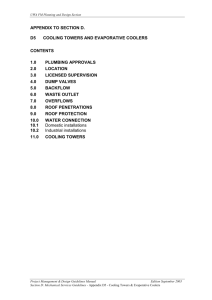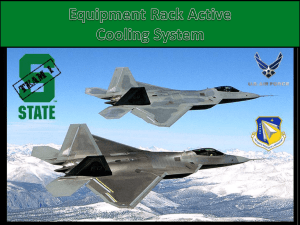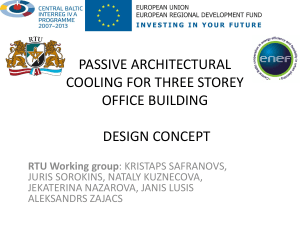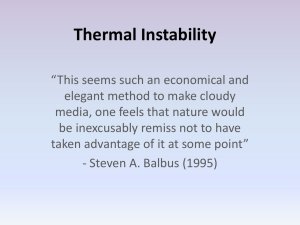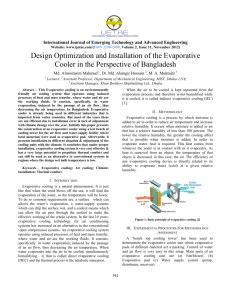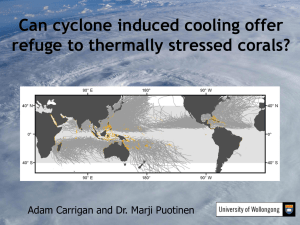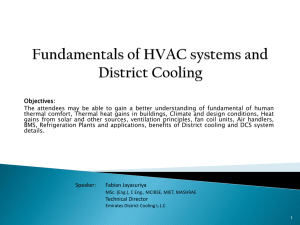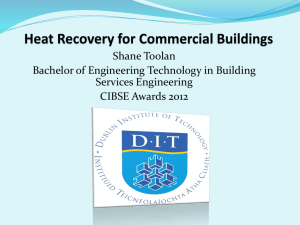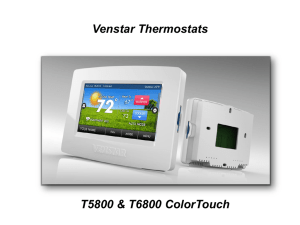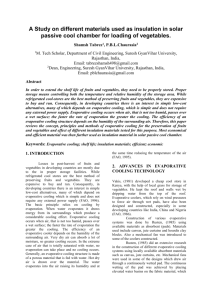Trouble-free Methods of Applying Evaporative Cooling for Energy
advertisement
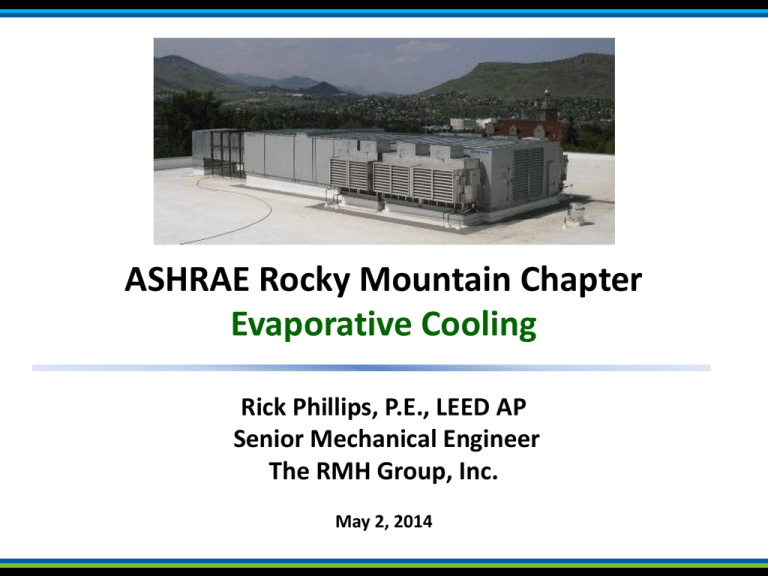
ASHRAE Rocky Mountain Chapter Evaporative Cooling Rick Phillips, P.E., LEED AP Senior Mechanical Engineer The RMH Group, Inc. May 2, 2014 1 Fundamentals Dry Bulb Temperature Wet Bulb Temperature Evaporation Wet Bulb Depression = DB – WB Design Day in Denver 93° DB, 59° WB 2 Direct Evaporative Cooler 3 Media 4 Performance Cooling EDB – LDB Effectiveness = EDB – EWB (%) 5 Indirect Evaporative Cooling 6 Hybrid Indirect Evaporative Cooler with Energy Recovery (Could be DEC) (Used as IEC) 7 Psychrometrics DIRECT INDIRECT INDIRECT / DIRECT 8 Direct Evaporative Cooling Pad Performance OA DB RANGE 95-99 90-94 85-89 80-84 75-79 70-74 65-69 60-64 55-59 MCWB 60 59 58 57 55 54 52 50 47 HOURS/ YEAR 3 118 235 348 390 472 697 699 762 4" PAD 8" PAD 12" PAD FINAL RM COND (74 DB) LAT (DB) LAT (DB) LAT (DB) (WB) (%RH) 77.4 67.6 64.1 63.05 57.3 74.5 65.8 62.6 62.65 55.9 71.6 63.9 61.2 62.13 54.1 68.8 62.1 59.8 61.59 52.3 65.3 59.5 57.4 60.64 49.2 62.5 57.7 56.0 60.09 47.4 59.1 55.1 53.7 59.1 44.2 55.6 52.5 51.3 58.23 41.5 51.7 49.1 48.1 56.75 36.9 Bin weather data, Denver, CO Doesn’t include fan temperature rise 9 Indirect/Direct Evaporative Cooling System Performance OA DB RANGE 95-99 90-94 85-89 80-84 75-79 70-74 65-69 60-64 55-59 MCWB 60 59 58 57 55 54 52 50 47 HOURS/ INDIRECT YEAR LAT (DB) 3 74.4 118 71.9 235 69.3 348 66.8 390 63.6 472 61.0 697 57.9 699 54.7 762 50.9 INDIRECT 4" PAD LAT (WB) LAT (DB) 52.13 62.6 51.86 61.3 51.71 60.0 51.43 58.6 50.01 56.4 49.85 55.1 48.43 52.9 47.11 50.7 44.35 47.4 8" PAD LAT (DB) 56.7 56.0 55.3 54.6 52.8 52.1 50.4 48.7 45.7 12" PAD FINAL RM COND (74 DB) LAT (DB) (WB) (%RH) 54.6 58.96 43.7 54.1 58.96 43.7 53.6 58.96 43.7 53.1 58.81 43.3 51.5 58.23 41.5 51.1 58.23 41.5 49.5 57.50 39.2 47.9 56.90 37.4 45.1 55.68 33.7 Bin weather data, Denver, CO Doesn’t include fan temperature rise 10 Typical Meteorological Weather Data (TMY2) Hourly weather data for a typical year (not averaged) – Includes typical extreme weather conditions Database includes conditions like this: – 78°F DB, 66°F WB • Under these conditions, direct evaporative cooling does not perform well. 12” PAD (LAT) 67°F DB Final Room Conditions 74°F DB, 76% RH 11 Typical Meteorological Weather Data (TMY2) Number of hours/year with high WB – > 60°F – 378 hours – > 63°F – 146 hours – > 65°F – 33 hours Using a 63°F DAT requires 67% more airflow than using 55°F DAT. 12 Systems that Can Use Higher SAT Displacement Ventilation 63F - 68F UFAD 60F - 64F Data Centers (hot aisle/cold aisle) 64F - 80F 13 For Conventional VAV Applications Combine chilled water with direct evaporative cooling Advantages –Can reduce chiller ton-hours/year by 2/3 ($$). –Can deliver 55°F DAT at any time. • Don’t have to oversize fans and ducts. –Can limit humidity levels in the building. Note: still requires a full-sized chiller 14 CHW/DEC Component Arrangement for Optimal Performance * Fan Upstream – 35% less CC energy : (compared to CC upstream of DEC) : (compared to DEC upstream of of CC) 15 For which types of buildings does evaporative cooling work? Direct evaporative cooling alone Warehouses Vehicle repair facilities Any type of building with low internal cooling loads Makeup air for commercial kitchens Gymnasiums Spaces that are open to the outdoors 16 For which types of buildings does evaporative cooling work? Indirect evaporative cooling combined with direct evaporative cooling Commercial office buildings Retail spaces Recreation center Any type of building with moderate to low internal cooling loads Direct and/or indirect evaporative cooling combined with CHW or DX cooling Any type of building 17 Pros Saves energy Works well in the Denver climate Low tech and easy to maintain with unskilled labor Lower cost than a chilled water cooling plant Can also be used to cheaply humidify air Direct evaporative cooling is inexpensive 18 Cons If not maintained properly, can produce odors If wrong materials are used, can have corrosion problems Poor construction can result in leaks and water carryover, resulting in flooding of the space below the unit People don’t understand how to maintain it or fix problems 19 Maintenance and Operation Dry the pad out daily. Drain the sump weekly. Run the pad wild. Don’t recirculate air. Pads last approx. 8-12 years. Pipe for maintenance (strainers, PRV, flowmeters, etc.). 20 Direct Evaporative Cooler Piping 21 Water Treatment Scale buildup prevention Continuous bleed or automatic control Biocides 22 Control Sequence Economizer (OA) Direct evap first Indirect/direct (if used) Direct with chilled water High humidity lockout 100% outside air whenever direct evap is active 23 Myths Legionella disease Over humidification Smell High maintenance High water usage 24 Typical HVAC Systems Estimated Total Water Consumption Air Cooled Chiller 2.8 COP = 10 Lb. H2O Ton-Hr DX Air Conditioner 2.8 COP = 10 Lb. H2O Ton-Hr Water Cooled Chiller 5.55 COP = 25 Lb. Ton-Hr (150 ton – 300 ton) Evaporative Cooler H2O 80oF (Direct/Indirect) O.A. = 21 Lb. H2O Ton-Hr Assumptions •Power plant overall efficiency of 35% •Average O.A. temperature of 80oF •Cooling tower bleed rates of 20% to 33% 25 Case Study − Golden Hill Office Center 212,000 sf office building constructed in 1983 Designed in conjunction with SERI (NREL) Model project for energyconscious design National ASHRAE First Place Energy Award for New Construction, 1988 26 Case Study − Golden Hill Office Center Features – – – – – – – – – 100% indirect/direct evaporative cooling system Solar hot water heating Three 10 kW roof-mounted photovoltaic arrays Passive solar design with east-west axis Six high-efficiency, condensing boilers Natural ventilation for parking garage Heat and light reclaimed from atriums to offices South side window overhangs 38 kBtu/sk/year measured without atrium; DOE 1995 energy evaluation of comparative buildings is 90 kBtu/sf/year – 43 kBtu/sf/year measured with atrium – 28 kBtu/sf/year with light shelves (not installed) 27 Case Study − Golden Hill Office Center Indirect/direct evaporative cooling process 28 Case Study − CU-Boulder ATLAS Center 66,000 sf of classroom, performance, and study space Opened for classes in August 2006 Features direct evap + CHW cooling, carbon dioxide monitoring, and VAV systems Certified LEED-NC Gold 4 points for optimizing energy performance – 30% reduction 29 Case Study − CU-Boulder Wolf Law Building Five-story, 184,000 sf Opened for classes in August 2006 Features direct/indirect evap + CHW cooling, carbon dioxide monitoring for demand ventilation, and VAV systems Certified LEED-NC Gold 30 Case Study − CSM Student Recreation Center 110,000 sf facility Direct/indirect evaporative cooling only – $500,000 deferred cost for chiller plant Natatorium – IEC – Outside air for humidity control Competition gymnasium – DEC/IEC 31 Case Study − Colorado Springs Utilities Laboratory Project Description – 45,000 sf (2/3 laboratory space, 1/3 office space) – Direct evaporative cooling with chilled water, energy recovery – Designed with the Labs-21/LEED Guidelines – Certified LEED-NC Silver – 50% energy savings compared to base case – USGBC-CO Bldg. of the Year Award 32 Case Study − Colorado Springs Utilities Laboratory 2 AHUs – 62,000 cfm for labs, 25,000 cfm for offices Annual chiller operating costs with chilled water cooling only $17,900 Annual chiller operating costs with combined chilled water/ evaporative cooling - $5,900 33 Case Study − Colorado Springs Utilities Laboratory Cost of adding direct evaporative cooling modules Equip. Cost Hookup/Controls Lab AHU $9,500 $2,500 Office AHU $6,000 $2,000 Total $12,000 $8,000 Payback with addition of evaporative cooling = First Cost/ Yearly Savings = $20,000/ $12,000 = 1.67 years (20 months) 34
